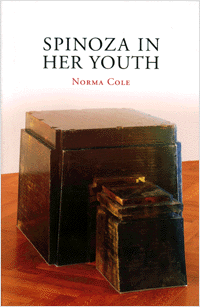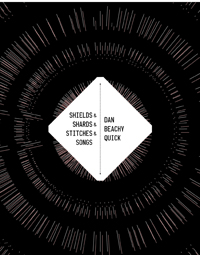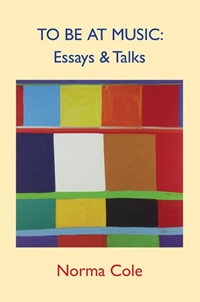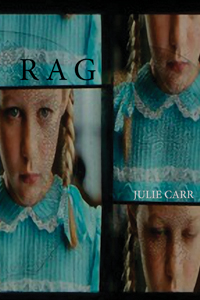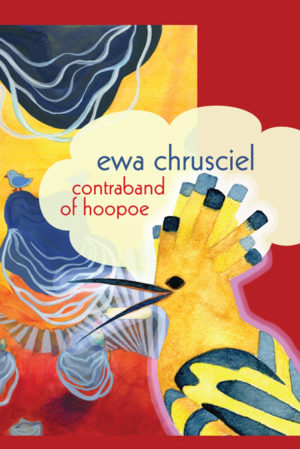Description
Norma Cole’s rich and rigorous poems delight in and disrupt the framing structures of language, memory, history, so as to inhabit new fluencies of possibility. Informed by a diversity of subject matter (including emotional, political, philosophic), each poem finds its balance of form and content upon the knifepoint of a lyric integrity that is as responsive to the gravity of experience as it is to the fallibility of our means of representing it.
[Cole] is a poet of consummate intelligence, a deft and compassionate company…
Robert Creeley
With this volume [Cole] reasserts her position as a major voice within contemporary poetry.
Andrew Benjamin, author of Art, Mimesis and the Avant-Garde and Present Hope
About the Author
Reviews
Excerpt
Norma Cole is a poet, painter, translator. Among her poetry books: Mars (Listening Chamber ’94), Moira (O Books ’95), and Contrafact (Potes & Poets ’96). Scout, a text/image work, is forthcoming (Krupskaya ’02). Translations include Crosscut Universe: Writing on Writing from France (Burning Deck ’00) and Anne Portugal’s Nude (Kelsey St. Press ’01). She teaches at San Francisco State University, the University of San Francisco, and in the MFA program at Otis College of Art & Design in Los Angeles. A Canadian by birth, Cole migrated via France to San Francisco where she has lived for the past twenty years.
…mixing verse and prose to trace varying forms of thought…. [Cole] achieves a rich abstraction that extrapolates the self’s refractions…
Publishers Weekly
The poetry of the fragment may have a long lyrical tradition, but Norma Cole renovates it most strenuously through syntactical instrumentalities that create shards made of language, not form – not form, but verbal artifact organized through informing differences, linguistic and cultural, which the phenomenal mind reads and rereads.
Spinoza in Her Youth gleams with a versatile, if not virtuoso, musicianship that reminds us of the pact joining Duncan to Oppen—both books stand as a fine claim to a “new” postmodern lyricism. This collection also demonstrates an intellectual versatility one would expect from such a fine translator of contemporary French poetry. Cole is a careful thinker—the disruptions and drifts of her new collection are placed with care and lead one to their own best thinking, given the chance.
Cole’s work, like the best of the Language School poetries with which her writing seems connected, is invested in theory and syntactical mysteries but not at the expense of joyful usage or raw energy. I admire the sheer adventure of this collection — the poems heed to no particular form, playing with punctuation, margins, type size, quotations, symbols, etc. and yet always feeling carefully and craftily composed.
Cole’s minding of both fluctuation and coercion delineates the possibility and compromise of being numerous, vigilantly.
Jennifer Scappettone, Poetry Project Newsletter
Cole is an unabashedly philosophical poet, as well as being firmly rooted in her process and boldly juxtaposes images of the quotidian and ‘subjectivity in the objectification of the gaze.’
Christopher Arigo, Pleiades
In Cole’s Spinoza, power’s feminine side is desire, the always doubled power of material forces, the very act of seeing, the different attributes (the language) of the same substances. Where power serves to crush by identification and repression, desire serves to dismantle, not to destroy, but to liberate through de-idealization, de-identification. This is the inspirational quality of Spinoza In Her Youth, the way the ideas do not lead to a state of idealization, but to the experience of their power to create: as Cole writes, ‘readership, a polymer.’ Later she adds, ‘How manifestations come after the end.’
Standard Shaefer, Aufgabe
from SPINOZA IN HER YOUTH
In the cavern of a story, a man and his book report.
^^^
^^^
Guess who I’m going up with?
Who? I pretend, asking not to know. Who has not pretended
THAT?
^^^
^^^
She bent lower over her armful of daises.
^^^
^^^
Caught up in the subjectivity emanating from the extending
phrases of the photographer/writer*, I am first one then the
other in this room, now through this reading existing.
^^^
^^^
The ever present sense of loss is neither sentimental nor
metaphorical, unless it can be apprehended as a metaphor for
itself.
^^^
^^^
“Before I lose it.”
^^^
^^^
Is she the same person as the little girl who once gathered daises
by the armful?
^^^
^^^
Light is the evidence of motion, the trace of gesture. Is the
image of the model then the evidence of stillness, its trace, its
stand-in?
^^^
^^^
It was a small apartment in fact. The dining room became the
spare bedroom when his mother-in-law visited. She visited six
months every year. Where did she live during the other six
months? A fan spins at the ceiling. The woman wearing shoes
with cork soles enters. They are slippers, but she uses them as
street wear.
^^^
^^^
In the dark in a long exposure he writes on her body with light
from a certain distance with his left hand as he stands by the
camera on its tripod. With his right hand he controls the length
of the exposure. The smell of burning charcoal interferes with
the voices.
^^^
^^^
Properties and Models:
Afternoons in cities have colors as do voices and faces. Individuals
sitting for their portrait seek their subjectivity in the objectification
of the gaze of the photographer “How do I look.” Here is
the camera’s inanimate lens, and here is the operator whose gaze
is of an unprecedented interiority. What to “present” to this
circumstance. He tells her to look at his hand, an oblique vertical,
doubt’s exclusion.
^^^
^^^
His Blindness:
In fact, he doesn’t believe in it.
^^^
*The blind photographer referred to is Evgen Bavcar.

